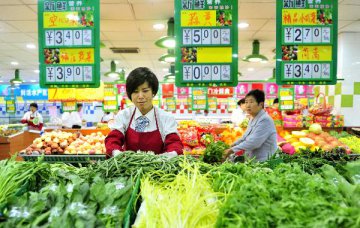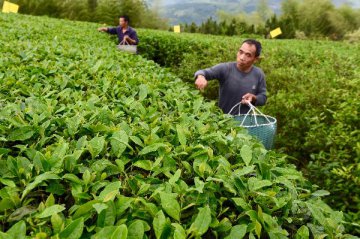
China's consumer price index (CPI), a main gauge of inflation, grew 2 percent year on year in May, official data showed on Thursday. The data narrowed from the 2.3-percent growth rate registered in the previous three consecutive months, when the CPI remained at its highest level since July 2014, data from the National Bureau of Statistics (NBS) showed.
NBS statistician Yu Qiumei attributed the inflation growth mostly to high food, cigarette and wine prices. Pork prices skyrocketed in May by 33.6 percent year on year, contributing 0.77 percentage points of CPI growth, while vegetable prices jumped by 6.4 percent, accounting for 0.14 percentage points of CPI growth. Food prices soared 5.9 percent year on year while non-food inflation edged up 1.1 percent in May. On a month-on-month basis, the CPI dropped 0.5 percent in May, the NBS said.
Since January, CPI data has been calculated using a new comparison base that takes new products and services into consideration, reflecting a change in consumption patterns. The adjustment slightly reduced the weight of food, which used to account for nearly one-third of the CPI calculation.
Food remains the major factor driving the index, said Tom Orlik, Bloomberg's chief Asia economist. "The CPI may fall further in the months ahead, as food inflation reverts to more normal levels," said Orlik. The producer price index (PPI), a measure of costs for goods at the factory gate, dropped 2.8 percent year on year in May, narrowing from a 3.4-percent drop in April and a 4.3-percent decline in March.
The contraction narrowed as a result of improved aggregate demand in the industrial sector. The reading marked the 51st straight month of decline as China's economic slowdown and industrial overcapacity weighed on prices.
HSBC attributed the easing PPI contraction to extended gains for bulk commodity prices and increasing infrastructure and property investments during the period.
Output price drops in oil, natural gas and coal, oil refining, ferrous metal smelting, chemical raw materials and chemical products contributed around 60 percent of the total producer price decline, said Yu Qiumei.
On a month-on-month basis, May's PPI inflation edged up 0.5 percent. Firmer prices in 2016 are making a bigger contribution to easing than all the central bank's rate cuts did in 2015, Orlik said, adding China's central bank has a reduced need to cut interest rates.
Data released on Wednesday showed China's imports in May grew 5.1 percent, significantly rebounding from a 5.7-percent decline in April, and also the first positive reading since late 2014. China's domestic demand is more resilient than expected, said Japanese securities brokerage Nomura.
However, growth of exports slowed to 1.2 percent year on year in May from 4.1 percent in April, customs data showed. "Sluggish external demand, uncertainties surrounding the property market, and the ongoing corporate restructuring activity all represent lingering risks to growth and prices," said Jing Li, an economist with HSBC.
Policy makers seemed well aware of these challenges. Last month, the State Council released a guideline on improving export performance, pledging to provide export firms with more financing support, better export tax refunds and simplified customs procedures. To this end, more pro-growth policies are still warranted in the coming quarters, Li said.
























Latest comments